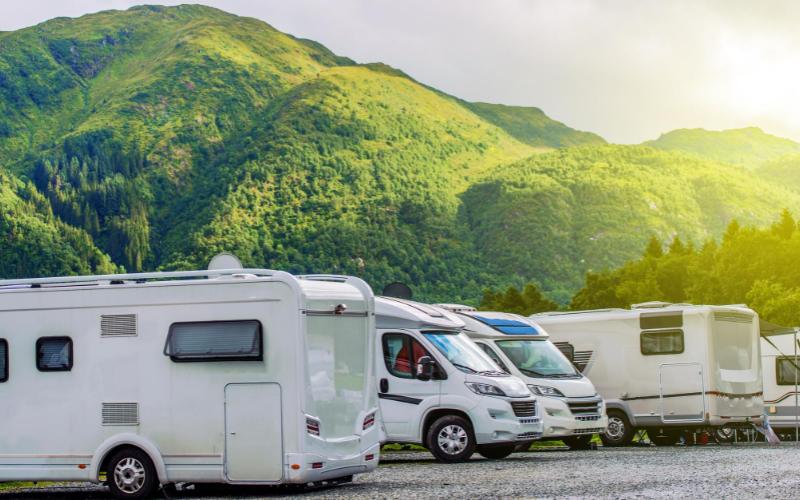Tips for Driving an RV in the Mountains

Driving an RV in the mountains can be an exciting adventure, but it also comes with unique challenges. The steep inclines, tight curves, and unpredictable weather can make mountain roads intimidating for even experienced drivers. However, with the right preparation and careful driving techniques, you can enjoy a safe and memorable journey. This guide will provide practical tips for driving an RV in the mountains, helping you navigate safely while making the most of your trip.
1. Plan Your Route Carefully
The first step to safe mountain driving is planning your route. Mountain roads are often narrow, winding, and steep. Not all RVs are suitable for every road, so check road restrictions before you start your trip. Use mapping tools designed for RV travel or GPS systems that account for vehicle height, weight, and length.
Avoid routes with hairpin turns or extremely steep grades if your RV is large. Identify rest stops, scenic pullouts, and fuel stations along the way. Knowing your route reduces stress and helps you focus on the road while driving.
2. Check Your RV Before You Go
Before embarking on a mountain trip, perform a thorough inspection of your RV. Check the brakes, tires, lights, and engine. Mountain driving places more stress on your vehicle than flat roads.
-
Brakes: Ensure they are in top condition. Descending steep grades relies heavily on braking power.
-
Tires: Mountain roads can be rough. Properly inflated tires with good tread improve traction.
-
Engine and Fluids: Check coolant levels, oil, and transmission fluid to avoid overheating.
-
Lights: Visibility may be reduced in fog or shaded mountain passes, so working headlights and brake lights are essential.
3. Understand Your RV’s Limitations
Every RV has limits in terms of weight, engine power, and braking ability. Knowing these limitations is critical for mountain driving. Large RVs may struggle to climb steep inclines or slow down quickly on descents.
-
Weight: Heavy loads affect acceleration and braking. Reduce unnecessary cargo when possible.
-
Length and Height: Some mountain roads have low bridges or narrow lanes. Always know your RV’s dimensions.
-
Engine Power: Older or smaller RVs may overheat or lose power on long uphill stretches. Plan frequent stops to allow the engine to cool if necessary.
4. Use Lower Gears on Steep Grades
One of the most important tips for driving an RV in the mountains is proper gear usage. Shifting to a lower gear helps maintain control while climbing or descending.
-
Uphill Driving: Lower gears provide more torque and reduce engine strain. Avoid excessive acceleration, which can overheat the engine.
-
Downhill Driving: Engine braking using lower gears can reduce wear on your brakes and prevent overheating. Avoid riding the brakes continuously.
5. Maintain a Safe Speed
Mountain roads require slower speeds due to sharp curves and sudden changes in elevation. Driving too fast increases the risk of losing control or not being able to stop in time.
-
Follow posted speed limits, which are often lower for trucks and RVs.
-
Adjust your speed for road and weather conditions. Wet or icy roads require even slower speeds.
-
Leave extra space between your RV and vehicles ahead, as stopping distances are longer on steep grades.
6. Brake Safely and Strategically
Braking in the mountains is different from braking on flat terrain. Overheating brakes is a common hazard for RV drivers. To brake safely:
-
Use engine braking whenever possible. Shift to a lower gear to slow down without relying solely on your brakes.
-
Apply brakes in short, controlled bursts instead of continuous pressure. This allows them to cool and reduces wear.
-
Avoid sudden stops unless absolutely necessary, as they can cause skidding or loss of control.
7. Be Aware of Weather Conditions
Mountain weather can change rapidly. Rain, fog, snow, and ice can all create hazards for RV drivers.
-
Check weather forecasts before starting your trip.
-
Carry chains if traveling in snowy regions.
-
Slow down in fog or heavy rain and use low beams to improve visibility.
-
Be cautious of black ice, especially in shaded areas or early mornings.
8. Watch for Wildlife and Road Hazards
Mountains are home to wildlife that can unexpectedly cross the road. Deer, elk, and smaller animals can appear suddenly, especially at dawn or dusk.
-
Stay alert and scan the road ahead for movement.
-
Reduce speed when approaching curves, forested areas, or wildlife crossing signs.
-
Keep your hands on the wheel and be prepared to stop safely.
9. Use Pullouts and Rest Stops
Mountain driving is more tiring than flat-road driving due to constant attention and maneuvering. Take advantage of pullouts and rest stops to relax and assess your RV.
-
Allow your brakes and engine to cool at designated areas.
-
Stretch your legs and stay hydrated. Fatigue can reduce reaction time.
-
Use scenic pullouts for breaks and photos, making your trip more enjoyable.
10. Practice Defensive Driving
Defensive driving is essential in the mountains, where conditions and other drivers can be unpredictable.
-
Keep a safe distance from vehicles in front of you.
-
Watch for aggressive or inexperienced drivers, particularly in curves and narrow lanes.
-
Use mirrors frequently to monitor vehicles behind, as passing may be difficult on steep or winding roads.
11. Use Proper Lane Positioning
Lane positioning can make a significant difference in mountain driving.
-
Stay in the right lane on two-lane roads unless passing.
-
Avoid cutting corners on curves. Mountain roads often have hidden drop-offs or oncoming traffic.
-
Keep your RV centered in the lane, giving extra space to the edge of cliffs or embankments.
12. Be Prepared for Emergencies
Mountain driving can be unpredictable, so being prepared is crucial.
-
Carry a first aid kit, flashlight, and basic tools.
-
Keep extra water and snacks in case of delays.
-
Have a plan for cell phone or radio communication in areas with limited signal.
-
Know the location of the nearest service stations or emergency facilities along your route.
13. Practice in Low-Risk Areas First
If you are new to RV mountain driving, practice in less challenging areas before tackling difficult routes.
-
Start with short, less steep roads to get comfortable with your RV’s handling.
-
Gradually increase the difficulty of your routes as confidence and skill improve.
-
Consider taking a professional RV driving course for specialized tips on mountain driving.
14. Stay Calm and Patient
Mountain driving can be stressful, especially when dealing with tight curves, large RVs, or other drivers. Patience is key.
-
Keep calm if traffic slows or conditions worsen.
-
Don’t rush; safety is more important than reaching your destination quickly.
-
Take breaks whenever needed to reduce fatigue and maintain focus.
15. Use Technology Wisely
Modern RVs come with technologies that can make mountain driving easier.
-
GPS systems designed for RVs help navigate routes suitable for large vehicles.
-
Backup cameras assist with maneuvering tight turns and parking.
-
Tire pressure monitoring systems alert you to potential hazards before they become serious problems.
16. Know When to Stop or Turn Around
Sometimes, the safest choice is to stop or turn around. Conditions may be worse than expected, or a route may be too difficult for your RV.
-
Don’t push your limits.
-
Look for safe locations to pull over if the road becomes dangerous.
-
Consult local authorities or experienced drivers if unsure about a route.
17. Consider RV Size When Choosing Routes
Not all RVs are suitable for every mountain road. Large Class A RVs may struggle on narrow, winding paths, while smaller Class C or camper vans may be more agile.
-
Research road conditions and restrictions in advance.
-
Plan your route based on your RV’s size, weight, and maneuverability.
-
Be ready to adjust your plans if conditions become unsafe for larger vehicles.
18. Keep Your Passengers Comfortable
Passenger comfort is also important on mountain trips. Sudden stops, tight curves, and long climbs can make travel uncomfortable.
-
Encourage passengers to wear seatbelts at all times.
-
Secure loose items in the RV to prevent injuries.
-
Provide snacks, water, and entertainment to make the journey enjoyable.
19. Enjoy the Scenic Views Safely
Mountain roads offer some of the most breathtaking views, but it is essential to prioritize safety.
-
Pull over at designated viewpoints rather than trying to take photos while driving.
-
Use your mirrors and backup cameras when maneuvering at scenic stops.
-
Remember that safety comes first, and enjoying the scenery responsibly enhances the experience.
20. Conclusion
Driving an RV in the mountains requires preparation, skill, and patience. By planning your route, understanding your RV’s capabilities, using proper driving techniques, and prioritizing safety, you can enjoy a memorable and safe mountain adventure. Whether you are a first-time RV driver or an experienced traveler, these tips will help you navigate steep grades, sharp curves, and changing weather with confidence. Remember to stay alert, practice defensive driving, and enjoy the journey — the mountains offer a unique blend of challenge and beauty that is unmatched by any other driving experience.
For more RV options and to make your mountain adventures possible, explore Popular RV, where you can buy and sell RVs online fast.




